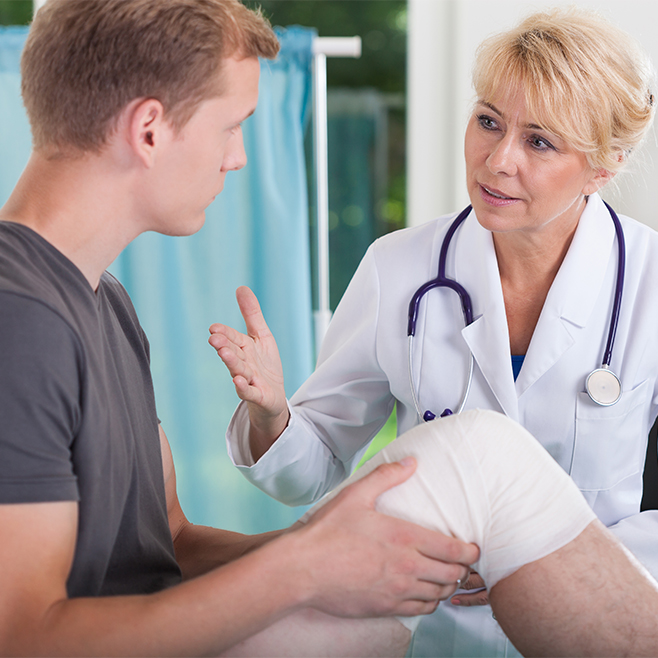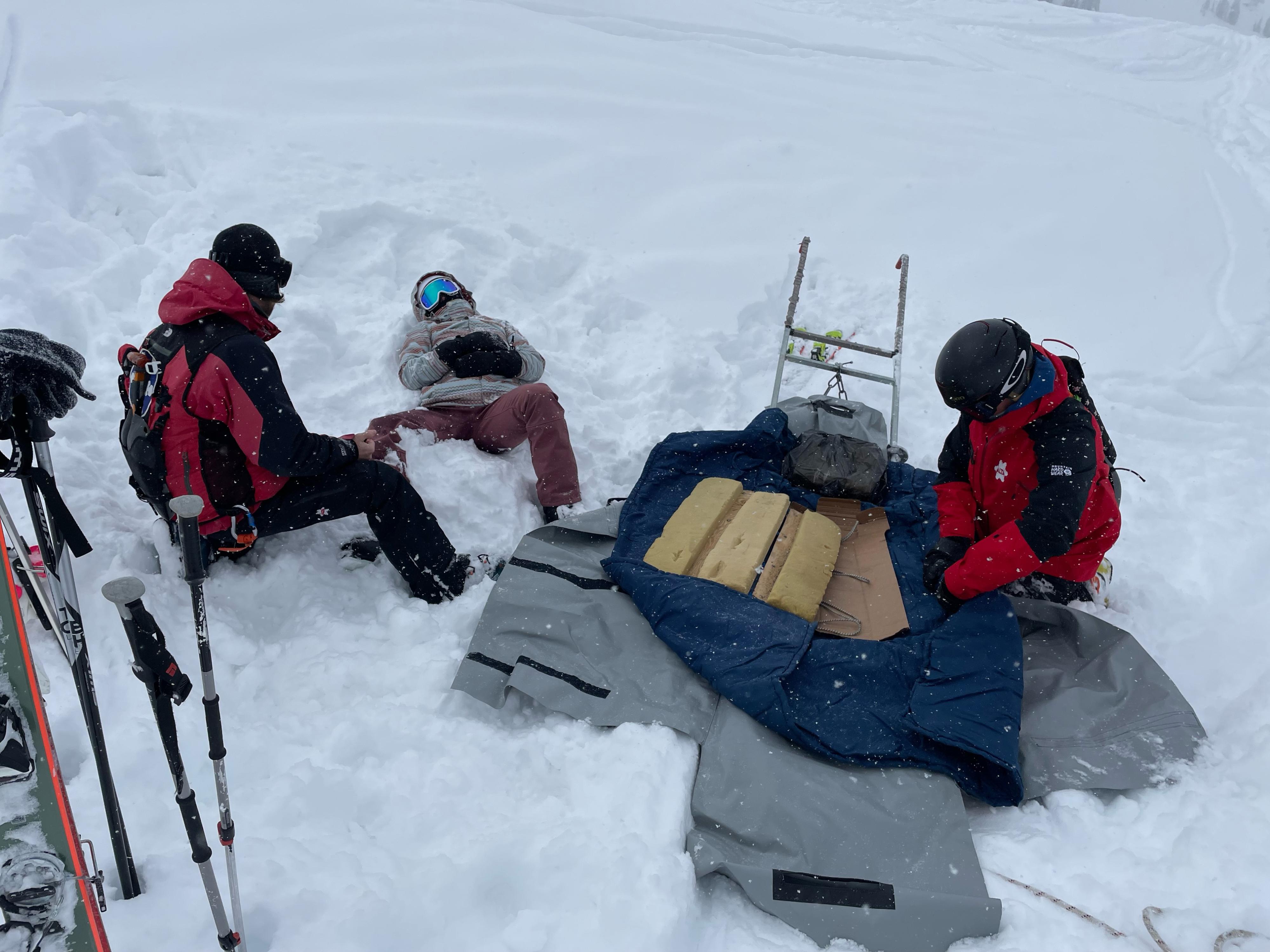

Signs of Knee Pain to Watch For
The knee pain symptoms you experience will depend on the location and type of knee injury, and may include:
- swelling in and around the knee,
- stiffness in your knee joint,
- limited mobility,
- limited range of motion,
- popping or "catching" sensation, or
- pain that makes it hard to perform daily activities.
Common Knee Pain Locations
Different types of knee pain cause different symptoms. The most common knee pain locations after an injury include:
- pain behind the knee,
- pain on the inside or outside of the knee, or
- pain on the front of the knee.
Knee pain that is a result of chronic injury or repetitive stress on the joint may start as mild pain that does not impact your ability to continue playing sports or participating in daily tasks. However, without treatment, this pain can get worse or lead to an injury.
Common Knee Injuries We Treat
Our orthopedic specialists treat the following knee injuries:
- Patellofemoral pain syndrome (runner’s knee) – This pain occurs in the front of your knee around the kneecap. It is more common in athletes, although anyone can experience this injury. This condition leads to pain and stiffness that makes it hard to kneel down, climb stairs, or do other daily activities.
- Patellar tendonitis (tendinopathy) – This overuse injury causes irritation in the tendon below the kneecap related to repeated explosive movements like jumping and landing.
- Ligament injuries – Your knee has four ligaments that can tear for a number of reasons, typically the result of a contact injury to the knee, but they can tear without any contact as well. Commonly injured ligaments include the ACL (anterior cruciate ligament) and MCL (medial collateral ligament), which usually happens after changing directions rapidly or landing on the knee awkwardly.
- Meniscal tears – Your knee has meniscal cartilage to absorb shocks between your thigh and shin bones. When this tough, rubbery substance is damaged it can cause knee pain. Meniscal tears can also happen over time from arthritis or aging.
- Bursitis knee – This is often the result of an injury or inflammation in the small fluid sacs that cushion and protect the structures around your knee.
- Osteoarthritis – The cartilage in your knee joint is a smooth surface that allows the joints to glide easily when you move. Injuries, wear and tear, being overweight, and aging can damage the cartilage, putting additional stress on the bones in your knee when they begin to rub together and leading to osteoarthritis.
- Fractures and dislocations – Knee fractures are most common in the kneecap, but could also happen to the femur (thigh bone) or tibia (shin bone). Dislocations occur when the knee bones are pushed out of place. These injuries are most common after trauma from things like falls, motor vehicle crashes, or contact during sports.
Mechanical problems in your knee or the surrounding joints and muscles can also lead to knee pain. Some of the most common include:
- loose bone or cartilage,
- hip or foot pain, or
- iliotibial band syndrome (tissues that run from your hip to your knee called the iliotibial band can tighten and rub against your thigh bone).
These injuries can be treated with knee surgery or with non-surgical interventions. The right treatment will depend on your diagnosis and other factors.
Find a Knee Specialist


When to Go to the Doctor for Knee Pain
Make an appointment to see a doctor right away if:
- You experience pain that significantly limits your range of motion.
- You cannot fully bend or straighten your leg.
- Your knee is “locked”.
- Your knee pain is accompanied by a fever, redness, and swelling.
- You have difficulty putting weight on your knee.
- You have pain with an obvious deformity in the knee joint.
- Your pain continues for more than two to three weeks.
- Your pain does not get better or worsens over time.
University of Utah Health has a walk-in Orthopaedic Injury Clinic with extended weekday hours if you need a same-day appointment and cannot get in to see one of our orthopedic doctors. Providers at the clinic can treat your immediate injury and refer you to an orthopedic specialist for follow-up care.
Knee pain that is a result of a traumatic injury, such as a collision in sports, a fall, or a vehicle crash, should be treated immediately.
ER vs. Urgent Care for Knee Injuries
Go to the emergency room (ER) for knee injuries that:
- have significant bleeding,
- involve broken bones,
- include puncture wounds,
- have serious swelling,
- won’t allow you to put weight on your knee,
- are accompanied by a fever, or
- if your knee looks red and feels hot to the touch.
Go to an urgent care or the Orthopaedic Injury Clinic for knee injuries with:
- moderate pain,
- swelling,
- bruising, or
- visible deformity in your joint.
How to Make an Appointment with an Orthopedic Specialist
We accept most insurance plans and most treatment is covered by insurance. However, some insurance plans have specific rules, such as requiring a referral from a primary care provider before seeing a specialist. Before visiting our clinic, check with your insurance carrier to verify that care from our clinic is covered under your plan.
If you have knee pain and would like to see an orthopedic specialist, contact our Orthopaedic Services at 801-903‑2306 to schedule an appointment.
You can also get a referral to see one of our specialists from:
- your primary care physician or other provider,
- visiting our walk-in Orthopaedic Injury Clinic, or
- visiting an urgent care or emergency room for acute care.
What to Expect at Your Orthopedic Appointment
We provide expert care and orthopedic evaluations for adults, adolescents, and children who are experiencing problems of the bones and joints. Our orthopedic specialists diagnose and treat everything from simple sprains and strains to complex conditions.
Hear From Our Patients
Medical School Student Grateful for Care from Ortho Injury Clinic
Polly Creveling, a third-year medical student at University of Utah, was skiing through two feet of deep, fresh powder when her ski got stuck in the hard snow below. An excruciating pain shot through her knee. She was diagnosed with both a torn ACL and a meniscus tear. With the in-depth comprehensive care she received from the Orthopaedic Injury Clinic and her orthopedic surgery team, she was able to continue her athletic lifestyle and participate in her med school rotations.





